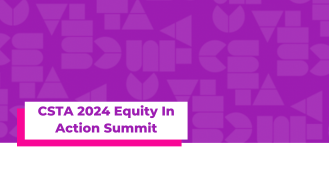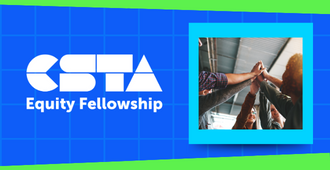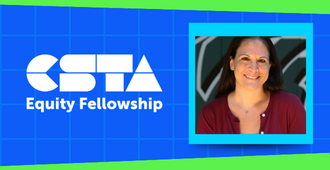
Carla Neely is a new CSTA+ member, has been teaching science and technology classes for over 20 years in her district, and is interested in getting as many of her students interested in CS as possible.
Full Story
Carla Neely is a new CSTA+ member and currently is a fourth- and fifth-grade STEM teacher at Warner Girls Leadership Academy, an African American all-girls school in Cleveland, Ohio. She has been teaching science and technology classes for over 20 years in her district and is interested in getting as many of her students interested in CS as possible. She advocates for more African American girls being introduced to CS opportunities beginning at the elementary school level. She is a recent Eduporium EdTech Grant Recipient. Follow her on Twitter here.
How did you prepare for the fall this summer?
Frankly, I wanted to rest this summer and decompress from the spring. Like many of us, I was “voluntold” to complete some professional development. My principal emailed me various professional development opportunities that were computer science based. I attended the Pathfinders Summer Institute which is the mecca of all CS professional development. I was interested in expanding my professional development in CS. I chose Wonder Workshop for my week-long training. Wonder Workshop is responsible for the Dash, Dot, and Cue robots. I also attended Code.org’s week-long training called Computer Science Discoveries (CSD) which is their curriculum for middle school students.
Can you share what you are looking forward to these days, amongst online learning?
Honestly, I’m looking forward to the pandemic being over and having my kids back in the classroom as I’m most comfortable as a hands-on teacher. In my classroom, amongst the changes this year of online learning, the BLM movement, and the political environment, I make space to talk about how the students are processing the news and noise. In asking how my students are feeling each week, we are creating that connection and transparency.
Of the many challenges that teachers face, can you share a recent issue you had to overcome?
Last week my district’s Microsoft 365 crashed, and we had to call it a day off of learning. I later found out that this was a national event that occurred. It was chaotic because I use Microsoft Teams for meetings. I couldn’t even communicate with my team or my girls. Thankfully, our school has finally purchased Zoom, so we can use that moving forward when issues arise.
 We have seen inequity arise during the pandemic, especially in education. Can you share your inequity observations while teaching this fall?
We have seen inequity arise during the pandemic, especially in education. Can you share your inequity observations while teaching this fall?
My students’ families and parents are struggling with online learning. As my school resides in a relatively low-income area, families’ understanding of technology, computer science, and even general usage of laptops is minimal. Many of the parents I work with did not have computers in their homes before our district provided our students with laptops, Chromebooks, and iPads. Therefore, I’ve had to reinforce and explain the importance of taking care of this technology. Most of my office hours on Wednesdays are spent helping train parents on using the laptops with their kids and the applications that students are using to learn.
In working with students and parents for over six months of online learning, what have you learned from your students?
They have taught me patience and appreciation. What I see as a norm for myself is not essentially a norm for them. As mentioned, when it comes to the accessibility to technology issues, I’ve always had access to a computer or an electronic processor, and these students haven’t necessarily had access at home to these items. I need to keep myself aware of the students’ environments and perspectives and keep calm when an issue arises.
What has been your strategy for keeping your elementary school kids engaged these days?
There are four major ways that I continue to keep my students motivated to learn in my classroom.
- Step 1: To help get student feedback and direction. I give them the power of decision by creating surveys to directly allow them to have input on what project they would like to work on next.
- Step 2: I show my students the finished product of a project to see the expectation and to create excitement about what their work could look like. Giving them an option to help create a video game or a website/blog gives them ownership in the learning process. After getting feedback and showing end products, the next step is to show them examples of completed projects by students in their grade band so they can be inspired.
- Showing students examples of games and websites that students have designed using helps them relate and spark creativity.
- Step 3: Give the students space to research and ask questions before beginning the assignment.
- Step 4: Finally, I provide motivation and drive for achievement to ask that their final project be something that they can share with friends, asking them to create a project that they would use in real life. If other students can use the product successfully, the project was done correctly.
What resource hasn’t been beneficial in the classroom lately?
Working out of a textbook has not been useful for my classroom, as it does not provide enough instruction or engagement for my students. I always need to supplement and be creative in what I use to increase effective instruction for my students. Making the classroom a personalized experience is vital. I reference textbooks, but we can’t rely on systems that aren’t built for virtual learning while virtually teaching. I look at the requirements needed for my CS students and then figure out how to deliver them creatively.
Recently, you attended our CSTA Virtual Teaching Summit. Can you share what sessions you found useful for your teaching?
I enjoyed the sessions that were directly focused on teaching CS to girls, and overall I thought the virtual summit was of value for CS teachers. Connecting with teachers who work with Girls Who Code and how other teachers support girls in their classroom was inspiring. I would like to see moving forward from CSTA is sharing resources or a webinar on how to get more girls in computer science and support other teachers who teach other subjects with how to incorporate small components of CS in their classroom. When we start to bring CS outside of one class into other subjects like English or even Math, students can build a greater understanding and connection to CS. We need to get the buy-in of other teachers to give students a taste of CS early on and set them up for success as they begin to pick classes in high school.
What specific resources do you use for your elementary school students?
Because I understand that most of my students have limited CS experiences, I utilize the Computer Science Fundamentals curriculum with my students. It was created by Code.org. With Computer Science Fundamentals, the students learn CS through block programming. Students can also work at their own pace.
When I begin incorporating robotics in my instruction, I use Wonder Workshop’s Dash & Dot robots. Their robotics curriculum is aligned to Computer Science Fundamentals. This means that when students are programming their robots, they can still use block programming. Wonder Workshop calls it Blockly.
My students also are learning how to use Micro:bits. Micro:bits use similar block programming as well. Students are able to complete many creative projects with a micro:bit, which is basically a small computer.
Because children and even teachers tend to get bored with doing the same things the same way all of the time, my goal is to introduce different types of CS that use the block programming format. This keeps the students motivated to continue learning CS in my classroom.
What would you like to share with other CS teachers?
It’s key to be flexible; we have to be willing to reinvent ourselves. We have to continuously understand that we must reinvent ourselves in order to be effective teachers. Understand that it’s ok to make mistakes and learn from them, and have those conversations with students.


 We have seen inequity arise during the pandemic, especially in education. Can you share your inequity observations while teaching this fall?
We have seen inequity arise during the pandemic, especially in education. Can you share your inequity observations while teaching this fall? 

